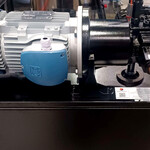World Water Day: hydroelectric plants are the protagonists
Today, March 22, we celebrate World Water Day, a day dedicated to raising awareness of the importance of water and promoting policies for its sustainable management. On this occasion, we want to focus on one of the technologies that use water as an energy source: hydroelectric energy.
Hydroelectricity is one of the most used renewable energy sources in the world. It is based on using the force of moving water to generate electricity. This type of energy is produced using waterfalls or dams that slow down the flow of water, creating a potential kinetic energy that is converted into electricity through turbines.
One of the main reasons hydropower is so popular is its sustainability.
Unlike other sources of energy, such as oil or coal, hydropower does not emit greenhouse gases that are harmful to the environment. Furthermore, water is a renewable energy source, which means that it does not run out and is not subject to market price fluctuations.
Hydroelectric power plants can produce large amounts of energy at relatively low cost, have high energy efficiency, and unlike energy sources such as solar or wind energy, which can be affected by climate and weather conditions, hydroelectric power it can be produced continuously, which makes it particularly suitable for supplying base energy to the electricity grid.
Some data
According to the analysis of the International Energy Agency, Hydropower Special market Report, hydroelectric energy is among the best sources of renewable energy. In 2020 hydroelectricity supplied about 4500 TWh, a sixth of the world's electricity production, and today it produces more than 50% in 35 countries around the world. In Europe alone, the installation of 254 GW of power produces approximately 670 TWh, accounting for 29% of world hydroelectric energy production.
Hydroelectric plants in Italy
The world's first hydroelectric power plant built in 1879, in the United States, at Niagara Falls. Shortly afterwards, the first national electric generator driven by hydraulic power was built in Chiavenna, in Lombardy; the first real Italian hydroelectric plant was activated in 1895 in Paderno d'Adda (LC) followed shortly after by the Vizzola Ticino plant (VA).
Today in Italy hydroelectric energy represents one of the main sources of renewable energy and contributes significantly to the production of electricity. With approximately 4,500 hydroelectric plants and 45 TWh, it represents 40% of total electricity. Large structures give way to smaller ones, with reduced environmental impact, which take advantage of the most recent technological-structural innovations. For example, low-head turbines have been developed to harness the force of water in low-velocity water streams, such as rivers, without the need to build large dams and hydroelectric power plants, flow control mechanisms are applied in turbines while operating at reduced flow and rotational speed variability and new systems for operating it in pumping mode.
The influence of the climate
The current situation of hydroelectric power in Italy, as in Europe, has been significantly influenced by the climatic conditions of recent years, in particular by the drought which has significantly reduced the amount of water available for the production of hydroelectric energy. This had a negative impact on hydroelectric energy production in Italy, with a 30% reduction in production compared to the average of previous years.
This situation has generated some concerns regarding the security of energy supply in Italy, since hydroelectricity accounts for a significant part of the country's electricity generation. Furthermore, the reduction in hydroelectric energy production has caused an increase in electricity prices on the Italian market.
However, hydropower must continue to represent a strategic source of renewable, clean, efficient and reliable energy that plays an important role in electricity generation worldwide.
To download our brochure and see Hydroservice solutions for the hydroelectric sector, register on our website and access the Download area!





